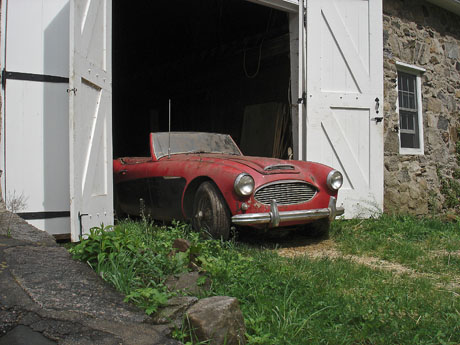SCM Analysis
Detailing
| Vehicle: | 1957 Austin-Healey 100-6 BN4 2+2 Barn Find |
| Years Produced: | BN4 from 1956 - 59; Austin-Healey 100/3000 from 52 |
| Number Produced: | first series BN4: 7,053All BN4's: 14,119 All Big Healeys: 73,004 |
| Original List Price: | $3,087 |
| SCM Valuation: | $25,000 - 40,000 |
| Tune Up Cost: | $250 - $500 |
| Distributor Caps: | Original specs: $18 Oppearance: $85 |
| Chassis Number Location: | Plate screwed to firewall in engine compartment |
| Engine Number Location: | Plate rivited to top left side of block |
| Club Info: | Austin-Healey Club USA |
| Website: | http://www.healey.org |
| Alternatives: | 1955 - 59 MGA,1955-63 Triumph TR3, 1960-67 Sunbeam Alpine |
| Investment Grade: | C |
This car sold for $14,040, including buyer’s premium, at the Bonhams Greenwich auction on June 6, 2010.
Unusual, rare, and desirable are three words that are often used to describe a collectible automobile. However, this barn-find BN4 is an excellent illustration of how unusual and rare cars aren’t always desirable.
This car is one of the now-rare, six-cylinder, occasional four-seater Healeys from the first production series. These cars are certainly unusual because of their engine and interior details, but they are not considered desirable—except by a small cult among Healey enthusiasts.
The first-series BN4s are often referred to as “Longbridge Healeys” because most examples were assembled at the same Austin factory in Longbridge where the four-cylinder Healeys had been produced. Around the end of 1957, all British Motor Corporation sports car production was consolidated at the MG Abingdon plant. (For the anoraks, we should note that the term “Longbridge Healey” isn’t entirely accurate, as a very small number of these first-series BN4s were assembled at Abingdon during the transition.)
Based on its serial number, this particular car was produced at Longbridge around March 1957, and, if completely original, will have the C-series engine that BMC developed for use in its big Austin, Morris, and Wolseley family sedans.
Though they liked the idea of the four-seat body style (and had experimented with their own version, a prototype of which still survives), Donald and Geoffrey Healey were opposed to using that C-series six-cylinder engine. The power-to-weight ratio of the new Healey made using that engine uncompetitive in the sports car market. In their role as a development and competitions contractor to BMC, they had actually started development of an improved version of the engine before the BN4 was even introduced, and they had tested it in their first six-cylinder rally cars and land-speed-record Healeys.
After only 7,000 first-series BN4s were produced, BMC acknowledged their error, and the improved engine, with a four-port head and separate intake manifold designed by Weslake for Healey, was introduced at roughly the same time as Healey production shifted to Abingdon. However, because of other design issues, production of the BN4s was suspended temporarily, and the engine was first installed on the two-seat BN6 version of the Healeys.
When production of the BN4s was resumed in September 1958, the new, more powerful engine was used. In addition, the stronger bonnet design of the BN6 had been adopted, and many details of the interior had been changed to save on costs. In particular, the complicated attached, sliding top-bow mechanism from the first series was replaced with a removable design, with accompanying changes to the interior rear quarter panels. In addition, a simplified side-screen design was adopted, the locking external door handle was replaced by a non-locking version, and a simplified windshield washer was adopted—all to save costs.
All this makes the first series BN4s unusual, as they have many distinctive features that are not shared with later models. However, the under-powered engine made the cars less desirable than Healeys that came before and after, so few of these first-series cars have survived. Original ones are rarely seen, even at Healey gatherings.
The auction price of this least-desirable Healey model teaches us that any Healey in unrestored, but in complete and rolling condition, is worth at least $14,000 today. However, based on recent market prices, a completely restored and original first-series BN4 could be worth up to $40,000 to the right buyer. That buyer is someone who wants to own a seldom-seen version of the Austin-Healey.
Did this buyer get a good, entry-level project car? That depends on three things:
First, does it still have the original gallery-head engine? It may be under-powered, but it will be original, and the car will be capable of sustained long-distance touring at modern highway speeds, which is a great feature of the Austin-Healey.
Second, does the car still have its original top frame, side screens, glass washer bottle, and the other now-rare “Longbridge” parts? If not, it may be almost impossible to restore this car to its original condition.
Third, are the original body panels repairable at a reasonable cost? Forty years in a New England barn generally isn’t a recipe for preservation of body work. If extensive body work has to be done— in addition to completely replacing the interior—that $30,000 margin will evaporate quickly, and the new owner will be completely underwater.
If the first and the second factor are true, but the third is not, the new owner will be well advised to seek out the cult of Longbridge BN4 restorers and part out the car with the possibility of actually making a profit on the deal. For this particular car, the restoration road could well be slippery, coated with hundred-dollar bills, and end up in a dark place, very far underwater.
